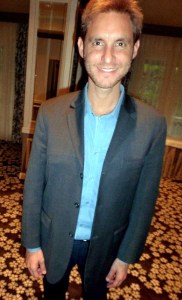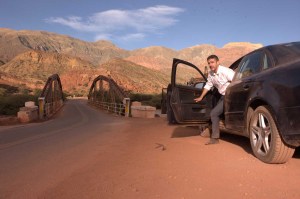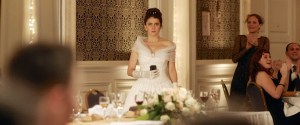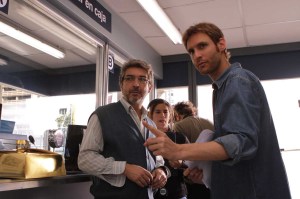![]()

The idea for the film originated when Argentinian director-screenwriter Damián Szifrón took a break from a span of film and television work. “From 2001 to 2006 I decided to dedicate myself to writing without directing for a few years,” he recalled. “It was a very creative period of time for me. I started a company Big Bang, because it reflects what was happening – a big bang of ideas.” In addition to writing some science-fiction novels, he turned out a series of “powerful short-stories, but I didn’t know what to do with them,” said the director. “When I put them together in one volume I realized they were connected by themes that provided unity and coherence. They were all about catharsis, vengeance and destruction. And the undeniable pleasure of losing control.”

Though Wild Tales, distributed by Sony Pictures Classics, is just opening this weekend in the U.S., the film has already been a box office bonanza in Argentina and other Spanish-speaking countries. And whether or not it triumphs at the Oscars, it has already garnered its share of kudos. Szifrón was nominated for the Palme d’Or at the 2014 Cannes Film Festival. And Wild Tales won a phenomenal 15 statuettes at Argentina’s equivalent of the Academy Awards out of 21 total nominations. Earlier this month in Spain, the movie, co-produced by well-known Spanish director Pedro Almodóvar and his brother Augustin, won a Goya for best Ibero-American film.
 Szifrón’s first impulse was to develop each of his stories into a separate movie, but that would take years so he decided to put them all in the same film. “I tried to compress them to a minimum, to give them the bonsai treatment,” he noted. Doing an anthology movie took more effort because it meant making six separate films. Each one had a different cast, but he decided to use the same crew throughout. “For me the main goal was to turn all these stories into a single cinematographic experience, the same ride,” he observed. “It’s like you’re on a train, and you go to all of these different cities, but it’s the same holiday. The same ride. To achieve that I thought it was better to work with the same cinematographer, the same crew. That way they would have same style.” Each episode was shot in totality before going on to the next one.
Szifrón’s first impulse was to develop each of his stories into a separate movie, but that would take years so he decided to put them all in the same film. “I tried to compress them to a minimum, to give them the bonsai treatment,” he noted. Doing an anthology movie took more effort because it meant making six separate films. Each one had a different cast, but he decided to use the same crew throughout. “For me the main goal was to turn all these stories into a single cinematographic experience, the same ride,” he observed. “It’s like you’re on a train, and you go to all of these different cities, but it’s the same holiday. The same ride. To achieve that I thought it was better to work with the same cinematographer, the same crew. That way they would have same style.” Each episode was shot in totality before going on to the next one.
Szifrón’s director of photography was Javier Julian. Though he’s worked with many well-known Argentine directors, he and Szifrón had never collaborated or even met before. They soon found they were on the same wavelength. “His cinematography was simple and sophisticated at the same time, and he was a key person for me not just in shooting each episode, but in the creation of the entire movie,” said the director. Early on, he said, “we considered making each episode look different. One would be in black and white, one would be shot in anamorphic with a 35 mm lens, and one could be done in video. But we decided it would distract people and not that much would be gained.”
 María Clara Notari was the production designer, concentrating on realistic details in what were often confined settings to make the most of the film’s budget. “Alfred Hitchcock always said if you have a fight scene in a hospital, don’t use guns, use hypodermic needles,” the director noted. “For the road rage episode I used everything in the car, from the stereo to the hood.”
María Clara Notari was the production designer, concentrating on realistic details in what were often confined settings to make the most of the film’s budget. “Alfred Hitchcock always said if you have a fight scene in a hospital, don’t use guns, use hypodermic needles,” the director noted. “For the road rage episode I used everything in the car, from the stereo to the hood.”
Szifrón likes to be his own editor. “I cannot separate the process of directing and editing the film,” he said. “For me it’s the most artistic moment. When you edit you feel like the painter in the room. You have the canvas, the colors and the paintbrush. You’re alone.” Another editor, Pablo Barbieri Carrera, did a first cut for each segment. “As soon as I finished shooting, I took a vacation for a week, and when I came back I was pleased with what he did.”
At that point he took the editing console to his house and spent seven months before he finished up. A lot of the time was spent refining performances. “I just needed time with six small movies to deal with and many takes,” he said.
 One of the strongest elements of Wild Tales is its captivating score. The composer Gustavo Santaolalla is a double Oscar-winner for Brokeback Mountain and Biutiful. Santaolalla was born in Argentina, became a rock-and-roll musician, and left when he was only in his teens. Wild Tales is the first score he’s done for an Argentinian picture. Szifrón knew it was a long-shot to get him, but sent him the script through someone they both knew. But he never heard back, even after writing more letters.
One of the strongest elements of Wild Tales is its captivating score. The composer Gustavo Santaolalla is a double Oscar-winner for Brokeback Mountain and Biutiful. Santaolalla was born in Argentina, became a rock-and-roll musician, and left when he was only in his teens. Wild Tales is the first score he’s done for an Argentinian picture. Szifrón knew it was a long-shot to get him, but sent him the script through someone they both knew. But he never heard back, even after writing more letters.
“The music was very important to me, and I knew I wanted an original score,” he declared. “I was finishing up shooting with no music and I was feeling desperate.” When the director went to Spain to consult with Pedro Almodovar he suddenly got a call from the composer. “’I just read the screenplay and I so much want to do it,’ he said to me,” noted the director. He immediately flew to Belgium where Santaolalla was attending a festival and, after a night of drinking and talking, they came to an agreement. “Two weeks later Gustavo called me and he said he had the music for the title sequence, and it was more than I could have expected.”





